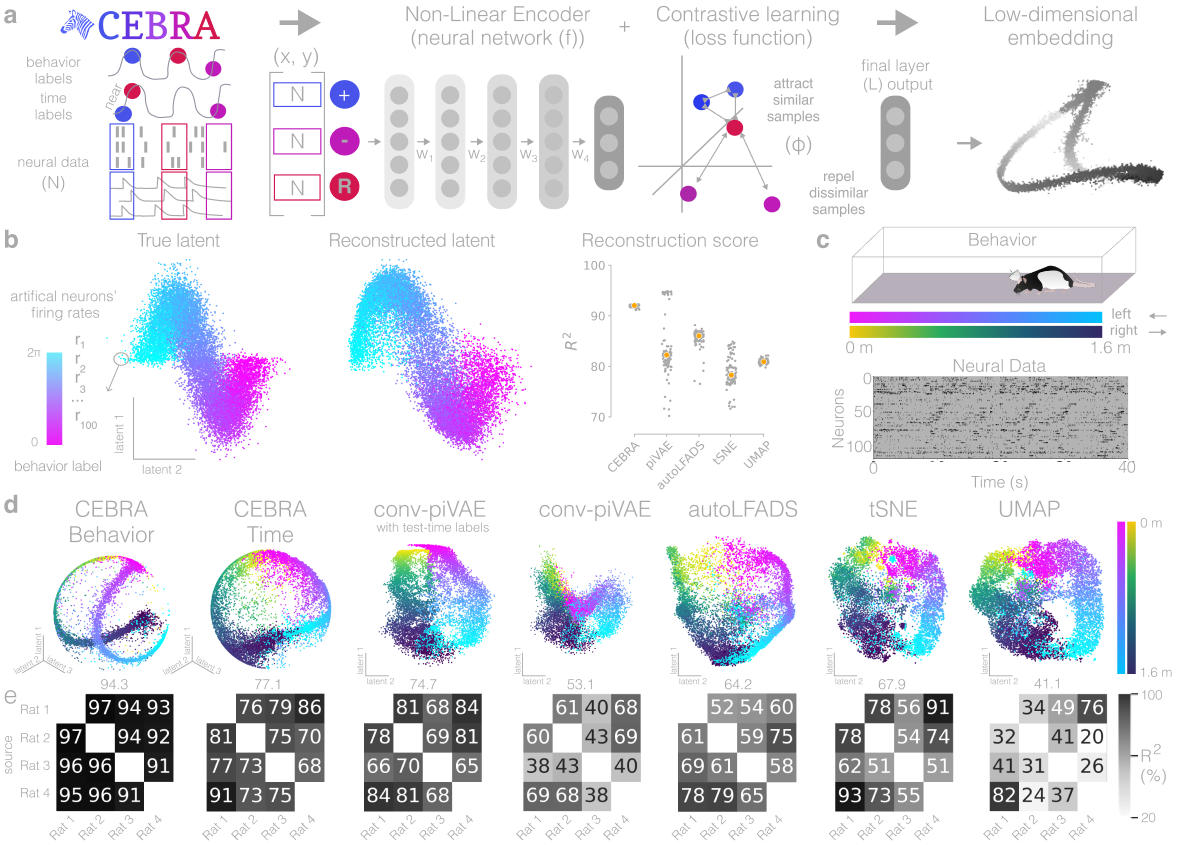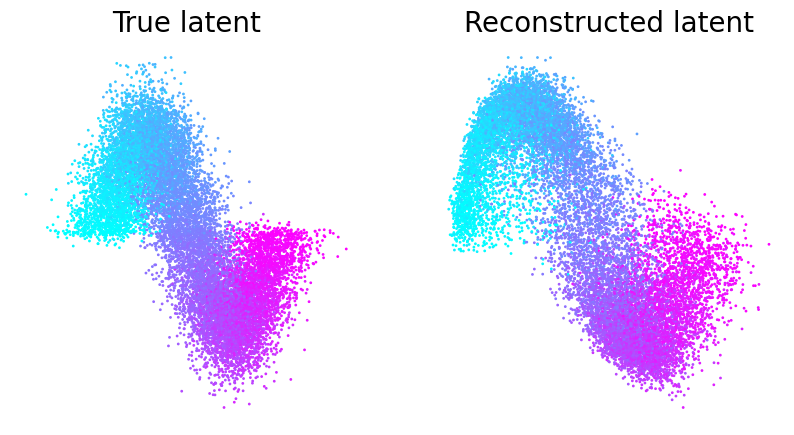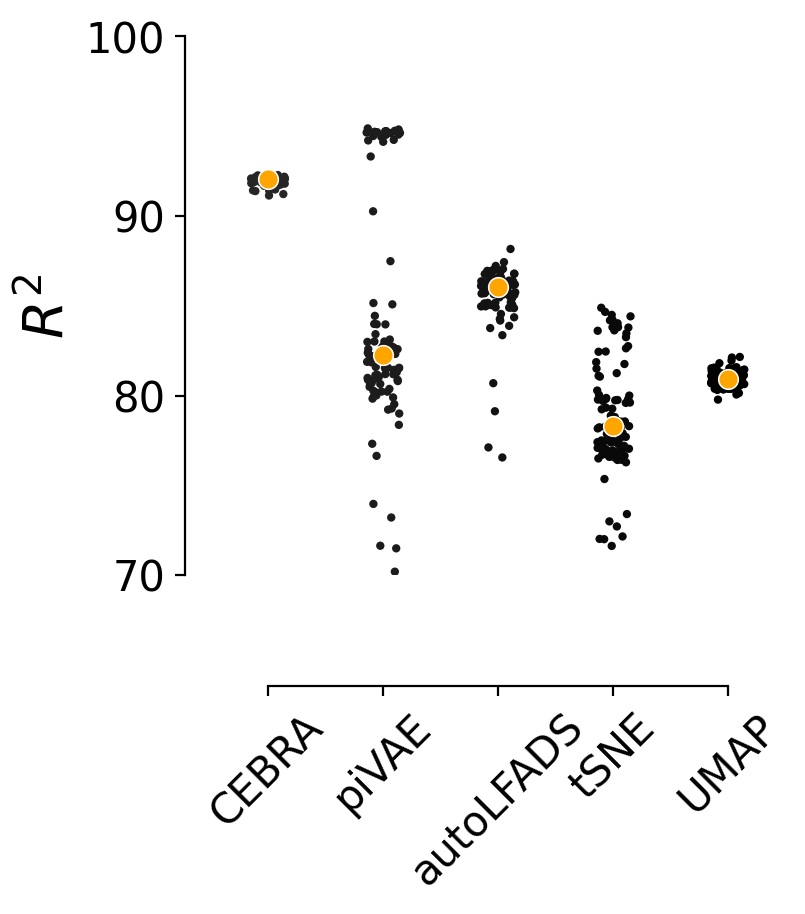Figure 1: CEBRA for consistent and interpretable embeddings#
For reference, here is the full figure

import plot and data loading dependencies#
[1]:
import numpy as np
import matplotlib.pyplot as plt
import seaborn as sns
import pandas as pd
import pprint
import seaborn as sns
import matplotlib.pyplot as plt
import numpy as np
import pandas as pd
import numpy as np
import pathlib
[2]:
data = pd.read_hdf("../data/Figure1.h5", key="data")
synthetic_viz = data["synthetic_viz"]
synthetic_scores = {
k: data["synthetic_scores"][k] for k in ["cebra", "pivae", "autolfads", "umap", "tsne"]
}
viz = data["visualization"]
Figure 1b (left):#
True 2D latent (Left). Each point is mapped to spiking rate of 100 neurons, and middle; CEBRA space embedding after linear regression to true latent. Reconstruction score of 100 seeds. Reconstruction score is \(R^2\) of linear regression between true latent and resulting embedding from each method. The “behavior label” is a 1D random variable sampled from uniform distribution of [0, \(2\pi\)] which is assigned to each time bin of synthetic neural data, visualized by the color map.
[3]:
plt.figure(figsize=(10, 5))
ax1 = plt.subplot(121)
ax1.scatter(
synthetic_viz["true"][:, 0],
synthetic_viz["true"][:, 1],
s=1,
c=synthetic_viz["label"],
cmap="cool",
)
ax1.axis("off")
ax1.set_title("True latent", fontsize=20)
ax2 = plt.subplot(122)
ax2.axis("off")
ax2.set_title("Reconstructed latent", fontsize=20)
ax2.scatter(
synthetic_viz["cebra"][:, 0],
synthetic_viz["cebra"][:, 1],
s=1,
c=synthetic_viz["label"],
cmap="cool",
)
[3]:
<matplotlib.collections.PathCollection at 0x139632320>

Figure 1b (right)#
The orange line is median and each black dot is an individual run (n=100). CEBRA-Behavior shows significantly higher reconstruction score compare to pi-VAE, tSNE and UMAP.
[4]:
plt.figure(figsize=(3.5, 3.5), dpi = 200)
ax = plt.subplot(111)
keys = ['cebra', 'pivae', 'autolfads', 'tsne', 'umap']
df = pd.DataFrame(synthetic_scores)
sns.stripplot(data=df[keys] * 100, color="black", s=3, zorder=1, jitter=0.15)
sns.scatterplot(data=df[keys].median() * 100, color="orange", s=50)
plt.ylabel("$R^2$", fontsize=20)
plt.yticks(
np.linspace(0, 100, 11, dtype=int), np.linspace(0, 100, 11, dtype=int), fontsize=20
)
plt.ylim(70, 100)
ax.spines["right"].set_visible(False)
ax.spines["top"].set_visible(False)
ax.tick_params(axis="both", which="major", labelsize=15)
ax.tick_params(axis = 'x', rotation = 45)
ax.set_xticklabels(
['CEBRA', 'piVAE', 'autoLFADS', 'tSNE', 'UMAP'],
)
sns.despine(
left=False,
right=True,
bottom=False,
top=True,
trim=True,
offset={"bottom": 40, "left": 15},
)
plt.savefig('figure1_synthetic_comparison.png', bbox_inches = "tight", transparent = True)
plt.savefig('figure1_synthetic_comparison.svg', bbox_inches = "tight", transparent = True)
/Users/celiabenquet/miniconda/envs/repro/lib/python3.10/site-packages/seaborn/categorical.py:166: FutureWarning: Setting a gradient palette using color= is deprecated and will be removed in version 0.13. Set `palette='dark:black'` for same effect.
warnings.warn(msg, FutureWarning)
/var/folders/d7/97cvt_0n63j6tygn4f5mfkzw0000gn/T/ipykernel_75712/3521837284.py:17: UserWarning: FixedFormatter should only be used together with FixedLocator
ax.set_xticklabels(

[5]:
import scipy.stats
from statsmodels.sandbox.stats.multicomp import get_tukey_pvalue
from statsmodels.stats.multicomp import pairwise_tukeyhsd
from statsmodels.stats.oneway import anova_oneway
def anova_with_report(data):
# One way ANOVA, helper function for formatting
control = scipy.stats.f_oneway(*data)
print(control)
a = anova_oneway(
data,
use_var="equal",
)
assert np.isclose(a.pvalue, control.pvalue), (a.pvalue, control.pvalue)
assert np.isclose(a.statistic, control.statistic)
return f"F = {a.statistic}, p = {a.pvalue}\n\n " + "\n ".join(
str(a).split("\n")
)
print(anova_with_report(synthetic_scores.values()))
F_onewayResult(statistic=251.26683383646048, pvalue=1.1211036071103506e-117)
F = 251.26683383646093, p = 1.121103607110032e-117
statistic = 251.26683383646093
pvalue = 1.121103607110032e-117
df = (4.0, 495.0)
df_num = 4.0
df_denom = 495.0
nobs_t = 500.0
n_groups = 5
means = [0.91992909 0.84069867 0.85632795 0.80919274 0.78808936]
nobs = [100. 100. 100. 100. 100.]
vars_ = [4.49920142e-06 3.85516265e-03 2.97498646e-04 1.68982912e-05
9.29583466e-04]
use_var = equal
welch_correction = True
tuple = (251.26683383646093, 1.121103607110032e-117)
[6]:
_, methods, values = pd.DataFrame(synthetic_scores).stack().reset_index().values.T
values = values.astype(float)
posthoc = pairwise_tukeyhsd(
endog = np.array(values), groups = np.array(methods).astype(str), alpha = .05
)
print(posthoc)
Multiple Comparison of Means - Tukey HSD, FWER=0.05
=======================================================
group1 group2 meandiff p-adj lower upper reject
-------------------------------------------------------
autolfads cebra 0.0636 0.0 0.0512 0.076 True
autolfads pivae -0.0156 0.0053 -0.028 -0.0033 True
autolfads tsne -0.0682 0.0 -0.0806 -0.0559 True
autolfads umap -0.0471 0.0 -0.0595 -0.0348 True
cebra pivae -0.0792 0.0 -0.0916 -0.0669 True
cebra tsne -0.1318 0.0 -0.1442 -0.1195 True
cebra umap -0.1107 0.0 -0.1231 -0.0984 True
pivae tsne -0.0526 0.0 -0.065 -0.0402 True
pivae umap -0.0315 0.0 -0.0439 -0.0191 True
tsne umap 0.0211 0.0 0.0087 0.0335 True
-------------------------------------------------------
Figure 1d#
We benchmarked CEBRA against conv-pi-VAE (both with labels and without (self-supervised mode)), autoLFADS, tSNE, and unsupervised UMAP. Note, for performance against the original pi-VAE see Extended Data Fig. 1. We plot the 3 latents (note, all CEBRA embedding figures show the first 3 latents).
The dimensionality (D) of the latent space is set to the minimum and equivalent dimension per method (3D for CEBRA and 2D for others) to fairly compare. Note, higher dimensions for CEBRA can give higher consistency values (see Fig. 4).
[7]:
def plot_embedding(ax, i, k, **kwargs):
fs = viz[k]
if len(fs) != len(l_ind):
nan = np.zeros((10, 2)) + float("nan")
fs = np.concatenate([fs,nan], axis = 0)
if not "cebra" in k:
ax.scatter(fs[r_ind, 1], fs[r_ind, 0], c=label[r_ind, 0], cmap="viridis", **kwargs)
ax.scatter(fs[l_ind, 1], fs[l_ind, 0], c=label[l_ind, 0], cmap="cool", **kwargs)
ax.axis("off")
else:
idx = [0,1,2]
ax.scatter(
*fs[l_ind][:, idx].T,
c=label[l_ind, 0],
cmap="cool",
**kwargs
)
ax.scatter(
*fs[r_ind][:, idx].T,
c=label[r_ind, 0],
cmap="viridis",
**kwargs
)
lim = 0.7
lim = -lim, lim
ax.set_xlim(lim)
ax.set_ylim(lim)
ax.set_zlim(lim)
ax.axis("off")
ax.set_aspect("equal")
label = viz["label"]
r_ind = label[:, 1] == 1
l_ind = label[:, 2] == 1
fig = plt.figure(figsize=(30, 5))
for i, k in enumerate(["cebra", "cebra_time", "pivae_w", "pivae_wo", "autolfads", "tsne", "umap"]):
if "cebra" in k:
ax = plt.subplot(1, 7, i + 1, projection="3d")
else:
ax = plt.subplot(1, 7, i + 1)
plot_embedding(ax, i, k, s = .5)
ax.set_title(k.title())
plt.show()

[8]:
# Uncomment to save the figures individually as high res PNGs:
#label = viz["label"]
#r_ind = label[:, 1] == 1
#l_ind = label[:, 2] == 1
#
#for i, k in enumerate(["autolfads", "umap", "tsne", "pivae_w", "pivae_wo"]): #, "cebra_time", "pivae_w", "pivae_wo", "umap", "tsne"]):
# fig = plt.figure(figsize=(4, 4), dpi = 1200)
# ax = plt.gca()
# #ax = plt.subplot(1, 1, 1, projection="3d")
# plot_embedding(ax, i, k, s = 5, edgecolor = 'none', alpha = 1)
# plt.savefig(f'{k}.png', transparent = True, bbox_inches = "tight")
# plt.show()
# break
Figure 1e#
Correlation matrices depict the \(R^2\) after fitting a linear model between behavior-aligned embeddings of two animals, one as the target one as the source (mean, n=10 runs). Parameters were picked by optimizing average run consistency across rats.
[9]:
def recover_python_datatypes(element):
if isinstance(element, str):
if element.startswith("[") and element.endswith("]"):
if "," in element:
element = np.fromstring(element[1:-1], dtype=float, sep=",")
else:
element = np.fromstring(element[1:-1], dtype=float, sep=" ")
return element
def load_results(result_name):
"""Load a result file.
The first line in the result files specify the index columns,
the following lines are a CSV formatted file containing the
numerical results.
"""
results = {}
for result_csv in (ROOT / result_name).glob("*.csv"):
with open(result_csv) as fh:
index_names = fh.readline().strip().split(",")
df = pd.read_csv(fh).set_index(index_names)
df = df.applymap(recover_python_datatypes)
results[result_csv.stem] = df
return results
ROOT = pathlib.Path("../data")
results = load_results(result_name="results_v3")
result_names = [
("cebra-10-b", "CEBRA-Behavior"),
("cebra-10-t", "CEBRA-Time"),
("pivae-10-w", "conv-piVAE\nw/labels"),
("pivae-10-wo", "conv-piVAE"),
("autolfads", "autoLFADS"),
("tsne", "tSNE"),
("umap", "UMAP"),
]
[10]:
def to_cfm(values):
values = np.concatenate(values)
assert len(values) == 12, len(values)
c = np.zeros((4, 4))
c[:] = float("nan")
c[np.eye(4) == 0] = values
return c
def plot_confusion_matrix(results, name, key, ax, **kwargs):
if name == "autoLFADS":
# please see the additional LFADS notebook for the source of
# this result matrix.
nan = float('nan')
cfm = np.array([[ nan, 0.52405768, 0.54354575, 0.5984262 ],
[0.61116595, nan, 0.59024053, 0.747014 ],
[0.68505602, 0.60948229, nan, 0.57858312],
[0.77841349, 0.78809085, 0.65031025, nan]])
else:
log = results[key]
cfm = log.pivot_table(
"train", index=log.index.names, columns=["animal"], aggfunc="mean"
).apply(to_cfm, axis=1)
(cfm,) = cfm.values
sns.heatmap(
data=np.minimum(cfm * 100, 99),
vmin=20,
vmax=100,
xticklabels=[],
yticklabels=[],
cmap=sns.color_palette("gray_r", as_cmap=True),
annot=True,
annot_kws={"fontsize": 12},
ax=ax,
**kwargs
)
return cfm
def plot_confusion_matrices(results):
fig, axs = plt.subplots(
ncols=8,
nrows=1,
figsize=(8*1.7, 1.4),
gridspec_kw={"width_ratios": [1,1,1,1,1,1,1, 0.08]},
dpi=1600,
)
last_ax = axs[-1]
for ax in axs:
ax.axis("off")
for ax, (key, name) in zip(axs[:-1], result_names):
cfm = plot_confusion_matrix(results, name, key, ax = ax,
cbar=True if (ax == axs[-2]) else False,
cbar_ax=last_ax if (ax == axs[-2]) else None,
)
ax.set_title(f"{name} ({100*np.nanmean(cfm):.1f})", fontsize=8)
return fig
plot_confusion_matrices(results)
plt.subplots_adjust(wspace = .5)
plt.show()

[11]:
# Uncomment to save the plots individually as PNG files in high res
#for key, name in result_names:
# plt.figure(figsize=(1.3,1.3),dpi=600)
# cfm = plot_confusion_matrix(name, key, ax = plt.gca(), square = True, cbar = False)
# plt.savefig(f'cfm_{key}.png', bbox_inches = "tight", transparent = True)
# plt.close()

